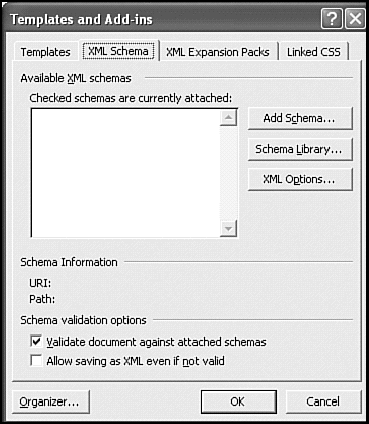XML Support
Finally, Microsoft has added extensive support for XML throughout Microsoft Office Professional and the standalone version of Microsoft Word. Word's XML support has received extensive publicity and is covered in detail in Chapter 25, "Using Word to Develop XML Content and Use XML Applications." This section briefly summarizes what XML is, and what Word's support can (and cannot) do for you.
XML is a widely accepted standard for representing any form of structured data?from text to database entries, and far beyond. Like HTML, XML is a markup language?you attach "tags" to data, and the tags indicate how the data should be handled. Like HTML files, XML files are composed of text; they are not binary files like conventional Word documents.
XML has at least three attributes that set it apart from HTML, and make it potentially far more useful?especially in business.
First, the rules for creating XML documents are far more restrictive than those for creating HTML documents. This means you can rely on XML to accurately communicate information between computer systems that cannot interpret the ambiguities and outright errors that are commonplace in HTML documents. As a result, XML is rapidly becoming the data exchange format of choice for an enormous range of business applications. Word's XML support means you can use Word to generate data for use by these XML-based applications, and that you can use Word to access data those applications already contain.
Second, unlike HTML, XML separates content from presentation. You won't find an XML tag to boldface text. Instead, you'll find tags that specify what information is?and what it means. This means it's easier to use XML as the format for documents that must be repurposed later; you merely attach a different style sheet that provides new instructions for how to format and display each type of data contained in the document.
Consider the widely quoted example of a pharmaceutical company that must use consistent, accurate, and up-to-date information on everything from consumer advertising to FDA reports. XML makes it possible to draw on the same information for all these uses, without having to worry about the inconsistencies that arise when source data must be stored in dozens of separate forms and locations.
Finally, unlike HTML, XML establishes rules that can be used to create a virtually infinite number of markup languages for specialized purposes and environments. To give you a sense of XML's breadth, consider these examples?just a few of the hundreds of XML dialects that have already been created:
XBRL, which standardizes the communication of financial reporting data among corporations
MathML, which provides a standard format for mathematical equations
WML, which provides a stripped down markup language for displaying Web applications on wireless phones
VoiceXML, which provides a standard language for controlling voice applications such as automated voicemail or call center systems
SVG, which defines an efficient format for 2D vector graphics
If you are using the standalone version of Word 2003, or the version of Word 2003 in Office 2003 Enterprise and Office 2003 Professional, you can work with any XML dialect supported by its own "XML Schema," using the XML Schema tab of the Templates and Add-ins dialog box (see Figure 1.10). You can even create your own internal schema, and use that.
Figure 1.10. Adding a custom schema in Word 2003.

However, the version of Word provided in less expensive versions of Office can only store and read documents using Microsoft's own proprietary, undocumented WordML schema?significantly limiting its usefulness in data exchange.
It's worth mentioning that, for most organizations, taking full advantage of Word's XML support will require planning, technical sophistication, and in many cases, custom programming.
Having said that, the versions of Word and Office that contain full XML support give organizations powerful new options for streamlining business processes, interacting with business partners, and delivering up-to-the-minute data to the people who need it, in a form they find easy to use.








